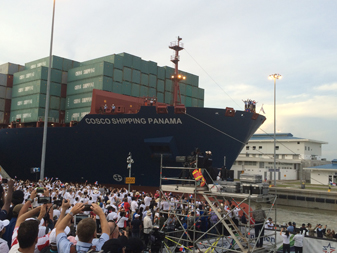|
By Peter Hurme
Cargo Business News contributor Peter Hurme was on hand for the recent, historic Panama Canal Expansion ceremony.
A full century after one of the greatest maritime infrastructure engineering feats opened the world up to new trade possibilities, a third, new set of wider locks at the Panama Canal welcomed its first neo-Panamax containership, as a recessionary shipping industry tests what could become the biggest bet yet over the future of how cargo from Asia transits to the populous eastern U.S., among other possibilities.
In the early morning hours of June 26, 2016, the 9,472-TEU COSCO Shipping Panama transited the Panama Cana's Agua Clara Locks from the Atlantic Ocean side of the Central American country as it continued towards the Pacific Ocean where heads of state, shipping industry leaders, a throng of journalists, and thousands of proud Panamanians awaited the vessel's arrival at the Cocoli Locks on the other side of its journey towards Asia.
 Photo credit: Peter Hurme
Photo credit: Peter Hurme
"We are thrilled that we currently have 170 reservations for neo-Panamax ships, commitments of two new liner services to the Expanded Canal, and a reservation for the first LNG vessel," said Panama Canal Administrator and CEO Jorge L. Quijano at the ceremony.
The 10-year, $5.25 billion canal expansion project experienced more than a few bumps in the road on its way to completion, including opening two years later than planned, while the size of containerships outpaced the scale anticipated by the ACP. The new third set of locks can handle containerships up to 14,400 TEUs in size, although there are now ultra large container vessels topping over 18000 TEUs.
"I think there is a point of diminishing returns," ACP deputy director Manuel Benitez said in an interview in Panama.
"When we were designing the [expanded] canal, we looked at several sizes because there's a tradeoff with the size of locks and the use of water."
Benitez said the ACP believes the "workhorse" containership size of the expanded canal will be between 8,500 and 10,000 TEUs. He added that, currently, 98 percent of containership sizes will be able to transit the new locks.
While two container-shipping recessions and larger ships couldn't have been on the ACP's radar over a decade ago, neither was the potential for energy-related shipping.
"Who knew the U.S. would become a net exporter of oil and gas?" said Benitez.
However, the biggest focus of the wider locks has been on the huge trans-Pacific trade from Asia to the U.S., where there have been, depending upon who you talk to, estimates of 10 percent to 20 percent more containerized freight transiting the canal to U.S. Gulf and East Coast ports.
Benitez said the initial projections of his group are at the more modest 10 percent level, which would still have some impact on the traditional U.S. West Coast intermodal rail network that has been able to promote its speed-to-market advantage over the Panama Canal route by an average of five days faster.
The domestic Southern California cargo market's population of 20 million-plus has been another bonus for carriers and their customers to call the Los Angeles-Long Beach port complex, in particular.
|
 Photo credit: Peter Hurme
Photo credit: Peter Hurme
But when the well-documented labor and congestion issues have arisen at the ports along the West Coast, including the more recent meltdown in the wake of new mega alliance equipment shortages and a testy longshore labor master contract renegotiation, cargo owners have been looking for alternatives.
These are some of the reasons U.S. East Coast ports like Miami are promoting their respective viability as an alternative to their West Coast counterparts.
The Florida East Coast Railway (FEC) forecasts up to 20 percent more containerized freight will reach the greater U.S. southeast via its network.
FEC chief executive Jim Hertwig said in an interview in Panama City that 10,000-TEU ships "could have two stops: Miami and Norfolk."
Port of Miami is the only container port south of Virginia on the U.S. East Coast that has a 50-foot channel depth to accommodate the larger neo-Panamax vessels. The port has on-dock rail and FEC acts as an alternative to trucking. The railway says it can reach 70 percent of the U.S. population in one to four days.
Hertwig said that as a result, Miami should blossom into a trans-shipment hub with trans-load and backhaul efficiencies, plus parlaying existing Latin American cargoes that "can add to an Asia carrier's density".
Other East Coast ports and their supply chain partners are delivering their own neo-Panamax marketing messages; while the shipping lines and their customers will be the ultimate drivers of how much more Asia-sourced shipping gold will arrive on eastern shores.
 Photo credit: Peter Hurme
Photo credit: Peter Hurme
"For Maersk Line globally, with 4 percent of our cargo passing through the canal it is not a change of such large magnitude, but for this geography it is important," said Maersk Line's head of network Anders Boenaes to Lloyd's List.
"We have a lot more containers passing through Suez, but that is a reflection of trading patterns. Our market share is larger on the Asia-Europe trades and the volumes are larger there, but we are also a big partner for the Panama Canal. The canal is starting cautiously below what we would expect to be the eventual capacity," he said.
Another Maersk executive said that, at least initially, the world's largest shipping company would be 'testing" the potential of the newly expanded canal.
The ACP's chairman of the board, Roberto Roy, who addressed the thousands of expansion ceremony attendees as the big COSCO ship slowly rolled by, remarked that the vessel was "sailing towards history." If that's the case, history will eventually be the ultimate judge of that success.
|

